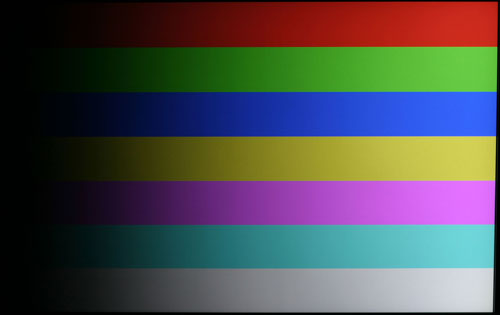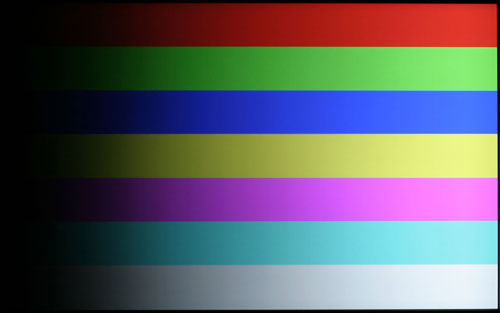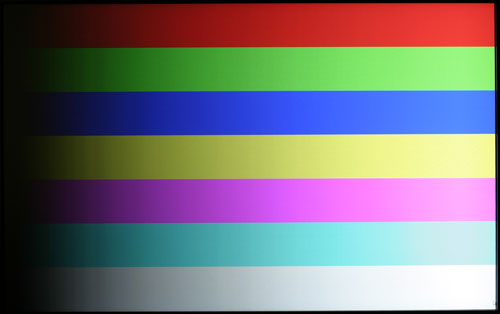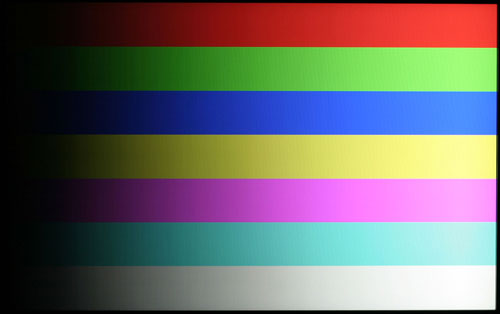Dell 2407WFP and 3007WFP LCD Comparison
by Jarred Walton on March 2, 2007 11:30 AM EST- Posted in
- Displays
Subjective Evaluation
Given that most users do not have access to hardware display calibration tools, we spent some time using the displays without ever properly calibrating them in order to gain an impression of how most users would react. We will start with our subjective evaluation before getting to the actual quantitative results.
Having used several LCDs including a Dell 2405FPW, the newer Dell models definitely look a little better in side-by-side comparisons. If you can't do a side-by-side comparison, though, it is much less likely that you would notice the difference. The newer displays look a little brighter and have slightly better colors and viewing angles, but we could be happy using pretty much any current 24" LCD. Outside of the lack of inputs and the massive size of the 3007WFP, subjectively there really wasn't a huge difference between the various LCDs.
One area that continues to be somewhat irritating on the 24" Dell LCDs is the default resolutions you get in Windows. Naturally 1920x1200 is present, and that will be the desired resolution if at all possible, but most other 16:10 aspect ratio resolutions don't show up and you need to use a utility to add support for 1680x1050 and 1440x900. If you lack the graphics hardware to run some games at native resolution, being able to drop the resolution down one notch while still maintaining a widescreen aspect ratio is convenient. The 30" Dell LCD does much better in the resolution department, with basically every resolution you would expect to find showing up without the need for any utilities/tweaks. We mentioned in the Gateway FPD2485W review that it appeared to have difficulty scaling 1680x1050 to fit its native resolution, while other resolutions scaled better. Both of the Dell LCDs seem to do better overall on scaling, although you still get the typical slightly blurred look when running at non-native resolutions.
The Gateway FPD2485W still holds the record as the brightest large LCD that we've used, but it's almost to the point of being too bright. We haven't felt the need to run any of the LCDs at maximum brightness, but in the case of the Gateway dropping it down to as little as 30% brightness at times was reasonable. So far, we have yet to experience an LCD that doesn't have a moderate amount of backlight bleed, and the brighter the display is the worst backlight bleed tends to be. After using the FPD2485W for a couple weeks, both Dell LCDs are a bit better at producing dark blacks, and unlike the Gateway LCD we didn't notice any issues with uniformity of color/lighting.
We took a closer look at the ability to reproduce a smooth color gradient on all of the displays we've tested so far. The Dell 3007WFP ranks at the top of the chart in terms of producing a smooth gradient, followed closely by the 2407WFP. Meanwhile, the Gateway FPD2485W and the older Dell 2405FPW show some banding issues when viewing gradients, particularly in the darker colors. People who do a lot of image editing are more likely to notice the problems in reproducing smooth gradients, and we actually weren't bothered by any of the monitors, but other users may be more demanding.
Trying to provide a good representation of what the gradients looked like is quite difficult, as you can't take a normal screenshot and using a camera to photograph the display is rather like making a copy of a copy. After a bit of trial and error, we were able to get images that at least convey something of the issues that we noticed with banding. You'll have to ignore the moiré effects that are present on some of the images, and our Canon Digital Rebel was only able to provide a rough approximation of what it's like to look at the screens in person, but for now this will have to do.
Something else we heard about was claims of lag/buffering on the Dell 2407WFP. We never noticed this during testing, but then when you consider screen updates are occurring every 0.017 seconds we're not entirely sure that our eyes are fast enough to pick up something like that. So we plugged a 2405FPW and 2407WFP into two DVI ports on the same computer and set the NVIDIA control panel to clone the output to both displays. We then took some pictures while running 3DMark03, with the 2405FPW on the left and the 2407WFP on the right. The second image is the more interesting, as a couple things become apparent. First, the 2407WFP is certainly no slower than the 2405FPW, and in fact it actually appears to be slightly faster in terms of pixel response times. Note how the frame counter shows 304 on the left and 305 on the right. Second, you can clearly see that there's still pixel lag present on both displays. Most of us don't have a problem with the slight image smearing that occurs on these LCDs, and the camera actually makes it look a lot worse than what we experience in person -- we may have simply captured two frames for all we know -- but this is something that will vary by individual. If you know you are bothered by image smearing, try out a display in person to see if it's suitable for your needs.
Overall, both Dell LCDs continue to rank among the best that we've seen, and with the current prices we would choose them over most competing offerings. We're still in process of reviewing other LCDs, of course, and eventually we expect someone to supplant Dell's current offerings as the preferred LCD, but we would put the 24" and 30" near the top of their respective categories. Certainly, they're more than worthy of serving as the standard against which we will judge future large LCDs. We would rate the 3007WFP as the better quality LCD panel in terms of colors, but only by a small margin, while the 2407WFP wins out in the features department. Whether it's playing games, viewing movies, or just surfing the web we didn't have any complaints about either display.
That's our subjective opinion of how the displays perform, but let's see how they fare in actual quantitative testing.
Given that most users do not have access to hardware display calibration tools, we spent some time using the displays without ever properly calibrating them in order to gain an impression of how most users would react. We will start with our subjective evaluation before getting to the actual quantitative results.
Having used several LCDs including a Dell 2405FPW, the newer Dell models definitely look a little better in side-by-side comparisons. If you can't do a side-by-side comparison, though, it is much less likely that you would notice the difference. The newer displays look a little brighter and have slightly better colors and viewing angles, but we could be happy using pretty much any current 24" LCD. Outside of the lack of inputs and the massive size of the 3007WFP, subjectively there really wasn't a huge difference between the various LCDs.
One area that continues to be somewhat irritating on the 24" Dell LCDs is the default resolutions you get in Windows. Naturally 1920x1200 is present, and that will be the desired resolution if at all possible, but most other 16:10 aspect ratio resolutions don't show up and you need to use a utility to add support for 1680x1050 and 1440x900. If you lack the graphics hardware to run some games at native resolution, being able to drop the resolution down one notch while still maintaining a widescreen aspect ratio is convenient. The 30" Dell LCD does much better in the resolution department, with basically every resolution you would expect to find showing up without the need for any utilities/tweaks. We mentioned in the Gateway FPD2485W review that it appeared to have difficulty scaling 1680x1050 to fit its native resolution, while other resolutions scaled better. Both of the Dell LCDs seem to do better overall on scaling, although you still get the typical slightly blurred look when running at non-native resolutions.
The Gateway FPD2485W still holds the record as the brightest large LCD that we've used, but it's almost to the point of being too bright. We haven't felt the need to run any of the LCDs at maximum brightness, but in the case of the Gateway dropping it down to as little as 30% brightness at times was reasonable. So far, we have yet to experience an LCD that doesn't have a moderate amount of backlight bleed, and the brighter the display is the worst backlight bleed tends to be. After using the FPD2485W for a couple weeks, both Dell LCDs are a bit better at producing dark blacks, and unlike the Gateway LCD we didn't notice any issues with uniformity of color/lighting.
We took a closer look at the ability to reproduce a smooth color gradient on all of the displays we've tested so far. The Dell 3007WFP ranks at the top of the chart in terms of producing a smooth gradient, followed closely by the 2407WFP. Meanwhile, the Gateway FPD2485W and the older Dell 2405FPW show some banding issues when viewing gradients, particularly in the darker colors. People who do a lot of image editing are more likely to notice the problems in reproducing smooth gradients, and we actually weren't bothered by any of the monitors, but other users may be more demanding.
 Dell 3007WFP |
 Dell 2407WFP |
 Gateway FPD2485W |
 Dell 2405FPW |
| Click to enlarge |
Trying to provide a good representation of what the gradients looked like is quite difficult, as you can't take a normal screenshot and using a camera to photograph the display is rather like making a copy of a copy. After a bit of trial and error, we were able to get images that at least convey something of the issues that we noticed with banding. You'll have to ignore the moiré effects that are present on some of the images, and our Canon Digital Rebel was only able to provide a rough approximation of what it's like to look at the screens in person, but for now this will have to do.
 |
 |
| Click to enlarge |
Something else we heard about was claims of lag/buffering on the Dell 2407WFP. We never noticed this during testing, but then when you consider screen updates are occurring every 0.017 seconds we're not entirely sure that our eyes are fast enough to pick up something like that. So we plugged a 2405FPW and 2407WFP into two DVI ports on the same computer and set the NVIDIA control panel to clone the output to both displays. We then took some pictures while running 3DMark03, with the 2405FPW on the left and the 2407WFP on the right. The second image is the more interesting, as a couple things become apparent. First, the 2407WFP is certainly no slower than the 2405FPW, and in fact it actually appears to be slightly faster in terms of pixel response times. Note how the frame counter shows 304 on the left and 305 on the right. Second, you can clearly see that there's still pixel lag present on both displays. Most of us don't have a problem with the slight image smearing that occurs on these LCDs, and the camera actually makes it look a lot worse than what we experience in person -- we may have simply captured two frames for all we know -- but this is something that will vary by individual. If you know you are bothered by image smearing, try out a display in person to see if it's suitable for your needs.
Overall, both Dell LCDs continue to rank among the best that we've seen, and with the current prices we would choose them over most competing offerings. We're still in process of reviewing other LCDs, of course, and eventually we expect someone to supplant Dell's current offerings as the preferred LCD, but we would put the 24" and 30" near the top of their respective categories. Certainly, they're more than worthy of serving as the standard against which we will judge future large LCDs. We would rate the 3007WFP as the better quality LCD panel in terms of colors, but only by a small margin, while the 2407WFP wins out in the features department. Whether it's playing games, viewing movies, or just surfing the web we didn't have any complaints about either display.
That's our subjective opinion of how the displays perform, but let's see how they fare in actual quantitative testing.










62 Comments
View All Comments
mongo lloyd - Saturday, March 3, 2007 - link
As for the .303mm pixel pitch, keep in mind that a 19" 4:3 1280x1024 screen that I would wager is the most common LCD in use right now is like .295mm and I never heard anyone complaining about the 19" displays...Well, you've heard one now. Out of ALL LCDs (minus the IBM T221, since that one is... a bit... special), the only panels I could ever begin to consider (and that's ignoring all the other faults with LCDs -- CRTs still beat them, and probably always will, if you ask me (at least as long as they use DVI with crappy refresh)) are the 30" 2560x1600 and 20.1" 1600x1200 monitors. I consider 1600x1200 on a good 19" CRT to be the optimal resolution, and the dot pitch on pretty much all LCDs are pitiful in comparison -- and the dot pitch is even more important on LCDs since the pixels are square and thus very sharp.
Also, you probably meant 5:4, not 4:3.
exdeath - Monday, March 5, 2007 - link
I love my F500R 21" .22mm AGP @ 1600x1200 CRT.But when it dies... there is no getting a replacement.
I have dual 1905FP Dell 19" LCDs at work, 1280x1024 5:4 .295 pitch and its quite sharp. They seem to be the standard by which I judge other LCDs by since that is what I am used to staring at all day. The higher pitch doesn't bother me at all.
In fact, being a graphics programmer and having a close up eye for pixel perfect detail, I tend to prefer images with sharp square pixels.
kmmatney - Saturday, March 3, 2007 - link
They do make laptop screens that are 15.4" and 1920 x 1200 resolution, which is a pretty amazing pixel pitch. So LCD dektop monitors are easily capable of better pixel pitch, there must just not be a market for them yet.Everytime I try 1600 x 1200 on a 19" CRT, it looks like crap, and I;'ve tried quite a few CRTs.
JarredWalton - Saturday, March 3, 2007 - link
Funny thing is, I go the other way. Laptop LCDs tend to have text that gets a bit difficult for me to read now. Oh, I can do it, but even 17" 1920x1200 displays are a bit tiny text/icons. I don't think I'd like a 15.4" 19x12 LCD. To each their own, of course.As for the rest, I fully agree that 1600x1200 on a 19" CRT looks pretty lousy - too small again, and I *love* the perfectly square pixels of LCDs. 20" (viewable) CRTs are required for proper 16x12 resolution, in my opinion. Refresh rates are definitely the one issue I have with LCDs - running CRTs at 100 Hz made it so I wouldn't notice shearing due to vsync, and you can't do that with LCDs. To counter that, though, all the pincushion, stretch, rotate, etc. necessary to get a CRT to properly fill the screen always irritated me. Heck, I'd even take an analog connection LCD over CRTs!
exdeath - Friday, March 2, 2007 - link
"Its a 27" compromise between the wider range of capabilities of the 30" and the smaller size of the 24" "Oops that should have been "limited range of capabilities of the 30"
JarredWalton - Friday, March 2, 2007 - link
I haven't used a 2707WFP yet, but I will see if I can get one sent for review.Take care,
Jarred Walton
Editor
AnandTech.com
lash - Friday, March 2, 2007 - link
First of all, thank you for the review. Does anyone know if this monitor suffer from input lag, like most of the 24" models ? Would it be hard to include a input lag test of the monitors reviewed ? Personally I think of it as a big problem when playing fps or online.Resh - Friday, March 2, 2007 - link
Thanks for the review, particularly the section on colour accuracy where you use objective measurement in the form of a colorimeter. Thanks!However, I note that I can't find the calibration targets you used. For example, when I calibrate my display, I'm targetting about 80 - 120 cd/m2 (depends on display type; brighter for LCD) for brightness, gamma 2.2, and a colour temp of 6500K or D65. This is important as it affects, particularly on LCDs, the display's ability to render colour accurately. For example, my Dell 2407FPW can perform with the level of accuracy that the review describes, but only when its brightness is allow to rise close to 300 cd/m2. While this is great for colour accuracy, it isn't very good for screen to print matching as the screen is far too bright for the print to match. Also, that kind of brightness is retina-searing!
In my case, my HP CRT is capable of astonishing accuracy at 80 cd/m2 -- the brightest it can go. If I screen match and make the drop the 2407FPW to that level, suddenly it isn't so accurate -- acceptable, but no match for the HP.
So it would be great if you could calibrate and profile to targets that are relevant for photographers and also make your targets known. Failing that, at least let us know what your targets were and how the eventual profile compared. For example, I asked ColorEyes Display to target 80 cd/m2 on my 2407FPW and the eventual result was 74 cd/m2.
Thanks!
JarredWalton - Friday, March 2, 2007 - link
I used the default (6500K 2.2 gamma), but I'll have to check on the white point value. Obviously, post-calibration it was still very bright (see page 6), so I may need to run calibrations for a lower white point. The Dell's can manage that, but the Gateway is sort of up a creek, since it couldn't get lower than 356 cd/m2 by adjusting the brightness. With contrast set lower, it might be able to get below 200 cd/m2, but probably not while providing any reasonable amount of accuracy. Sorry to say that I don't do anything with print, so that aspect of testing just didn't occur to me.strikeback03 - Monday, March 5, 2007 - link
I bought the Gateway over the weekend. It can go much lower than 356 cd/m^2 if you go to User color and lower the color channels all by the same amount. They ship set to 100, I lowered them all to 60 or so, which allowed me to set brightness to 120cd/m^2.I have some interesting calibration results, I'll post them in the Gateway comments when I get home from work.